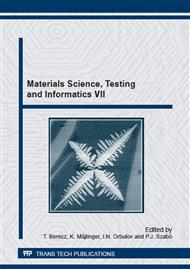p.321
p.327
p.333
p.339
p.345
p.351
p.357
p.363
p.369
Evaluation of Quenchant’s Cooling and Hardening Performance
Abstract:
One of the most critical parts of the heat treatment process, and usually the least controllable one, is the quenching operation. Improper selection or application of a quenching medium, or a drift in its cooling characteristics during its lifetime, may result in products that do not meet specifications and therefore give rise to large additional costs to cover e.g. straightening, rework, rejection, delayed deliveries and, sometimes, lost goodwill for the heat treater. In the case of the use of aqueous polymer solutions, the thermo-kinetic parameters characterizing the heat removal capabilities of a quenchant, are variable, in a specific interval with a complex combination of temperatures (T), concentrations (C) and agitation rates (AR). When the direction and degree of change is known, the characteristics of heat removal can be efficiently modified and predicted within given limits. The aim of the work described in this paper is to investigate how the hardening power of Houghton AquaQuench BW-T depends on the complex influence and interaction of T, C and AR.
Info:
Periodical:
Pages:
345-350
Citation:
Online since:
February 2015
Authors:
Price:
Сopyright:
© 2015 Trans Tech Publications Ltd. All Rights Reserved
Share:
Citation:


